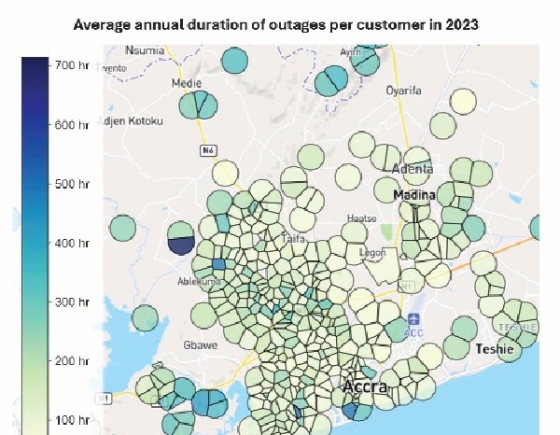
Groundbreaking data on power quality in Ghana
Improving power quality and reliability to foster economic development has been a longstanding vision of the Government of Ghana and the state-owned Electricity Company of Ghana (ECG).
However, this task has been more difficult due to the absence of high-resolution data on the performance of the power grid.
In 2018, the Government of Ghana, in partnership with the Millennium Challenge Corporation (MCC) and the Millennium Development Authority (MiDA), established a Power
Compact to address blackouts ("dumsor"), low voltage ("brownouts"), and high voltage ("whiteouts") by investing in grid improvements to support the ECG network.
nLine’s GridWatch Accra Dataset—generated as part of MCC’s Learning Impact Evaluation of the ECG Financial and Operational Turnaround Project—offers the most comprehensive insights to date into the quality and reliability of the electricity received by consumers in Ghana.
The data contain granular measurements of power quality in 14 ECG Districts across Accra. nLine is excited to release this dataset to support the on-going efforts of ECG, the Government of Ghana, and all other stakeholders in making the grid as reliable as possible.
The dataset covers 2018- July 2024 and has been collected with more than 1,200 sensors across 14 Districts of the Accra Regions of ECG, generating more than nine million data points.
These sensors provide granular, real-time data on power outages (blackouts), low voltage (brownouts), and high voltage (whiteouts). The following examples cover 2021-2024.
Major findings
The data shows that the best years for Accra’s grid over the last five years was 2022 and 2023. The Roman Ridge, Makola and Korle-Bu ECG Districts had the fewest number of outages in 2024.
The Kasoa South, Ablekuma and Nsawam, ECG Districts recorded the highest number of outages. Kasoa South experienced 209 outages in 2024 which is eight times the number Roman Ridge experienced.
The data also showed that ECG’s most reliable distribution transformer is located in Kaneshie.
It also shows that voltage quality improved significantly in the last three years. The average measured voltage was 227V in the last three years compared to 216V in 2021.
Electricity customers in Kasoa South and Legon ECG Districts experienced the least brownouts in 2024. Dansoman District experienced the most brownouts, averaging more than 3 hours of low voltage each day in 2024.
Customers in the ECG Districts of Nsawam, Ablekuma and Dansoman experienced the least amount of over-voltage in 2024. Kasoa South District received the most power surges, averaging more than 117 minutes of overvoltage daily, with the risk of damaging electric appliances.
Importance of real-time data
Evidence-based decision making: The dataset provides policymakers, utility managers, and other stakeholders with actionable insights to prioritize investments, design effective interventions, and optimize energy distribution. The length of the dataset provides a clear view of trends and long-term impacts of interventions.
Enhanced grid management: By pinpointing specific problem areas of the grid, ECG and its partners can focus their resources on the most-affected districts, leading to better allocation of funds and faster response times to outages, ultimately improving service delivery and customer satisfaction.
Citizen empowerment: Transparency in data allows for greater accountability. Citizens and advocacy groups can use this data to engage in better-informed dialogues with power providers and policymakers, pushing for improvements where they are most needed.
Knowledge development: The dataset offers a valuable resource for academia, enabling research on the relationship between energy infrastructure and industrialization in developing economies. With detailed data on outages and voltage fluctuations, researchers can analyze power quality impacts on productivity and economic growth, while also developing new algorithms, models, and technologies to enhance the efficiency and resilience of power systems.
Partners involved: This initiative was made possible through a multi-stakeholder partnership: Millennium Challenge Corporation (MCC) provided financial and technical support under the Ghana Power Compact.
Millennium Development Authority (MiDA) acted as the implementing agency, coordinating the project’s execution on the ground.
nLine Inc. used the advanced sensor technology and data analytics of its GridWatch system to provide a granular view of power quality and reliability.
Way forward
nLine’s success in Accra lays the groundwork for future expansions in Ghana and beyond. Monitoring in Accra will continue for the next three months through collaborations with PURC and funding from GIZ Ghana.
Along with the work in Ghana, nLine has collected power quality data from 10 countries across Africa to support governments, utilities, public and private investors, and the broader research community. Strategic Impact on Ghana’s Energy Future
Alignment with national goals
The dataset aligns with Ghana’s long-term energy sustainability goals by providing data-driven insights that support policy reforms, infrastructure investments, and energy sector modernization efforts.
It also presents valuable opportunities for academic research, technological innovation, and the development of new tools for power management and optimization.
To ensure the data remains relevant, nLine and its partners plan to update the dataset regularly, allowing for ongoing analysis, stakeholder engagement, and adaptive management.